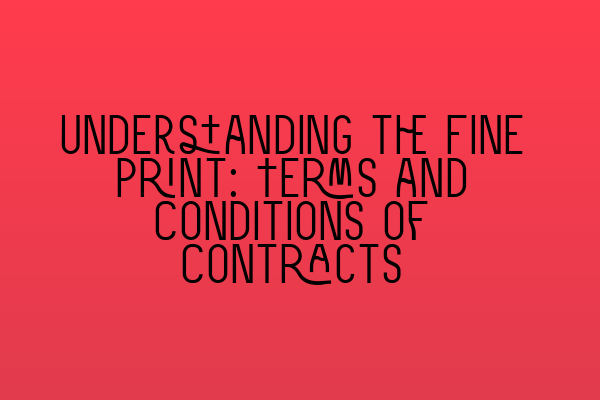Understanding the Fine Print: Terms and Conditions of Contracts
When it comes to signing a contract, many people tend to overlook one crucial aspect – the terms and conditions. These fine-print details may seem tedious and convoluted, but they play a vital role in protecting your rights and responsibilities. Failing to comprehend the terms and conditions could lead to unforeseen consequences and potential legal disputes. In this article, we will delve into the significance of understanding the fine print and provide you with valuable insights on how to navigate contract terms and conditions effectively.
1. The Importance of Reading Terms and Conditions
Imagine purchasing a product or service without reading the accompanying terms and conditions. You may unintentionally be binding yourself to obligations you didn’t even know existed. Terms and conditions outline the rights and obligations of both parties involved in the contract. By reading them thoroughly, you can ensure that you are aware of your rights, limitations, and any potential risks associated with the agreement.
2. Ensuring Clarity and Transparency
Terms and conditions serve as a legally binding agreement between two parties, and their purpose is to establish clarity and transparency. They define the scope of the agreement, the obligations of each party, and the consequences of non-compliance. It is crucial to carefully review these terms to avoid any misunderstandings or misinterpretations that could arise in the future.
3. Examining Key Elements in Terms and Conditions
a. Payment and Fees: The terms and conditions of a contract often specify the payment schedule, method of payment, and any additional fees that may be incurred. Understanding these details will prevent any surprises or disagreements regarding the financial aspects of the agreement.
b. Termination and Renewal: Contracts usually outline the conditions under which either party can terminate the agreement. It is essential to be aware of the notice period and any penalties or fees associated with early termination.
c. Intellectual Property Rights: If the contract involves intellectual property, such as copyrighted material or trademarks, it is crucial to understand the terms surrounding ownership, licensing, and permitted usage.
d. Liability and Indemnification: The terms and conditions may address liability concerns, such as clarifying who is responsible for damages or injuries that may occur during the duration of the contract. Additionally, the agreement may specify the extent of liability insurance coverage and indemnification clauses.
4. Seeking Legal Advice
Understanding complex legal jargon can be challenging for those without a legal background. If you find yourself faced with complex terms and conditions, it is advisable to seek legal advice. A solicitor specializing in contract law can help you comprehend the content, clarify any ambiguities, and ensure that your interests are protected.
5. Regularly Reviewing and Updating Terms and Conditions
Contracts are not set in stone and may need to be revised and updated as circumstances change. It is essential to regularly review your existing contracts and make necessary amendments to reflect developments in your business or personal life. By doing so, you can maintain compliance and adapt to new legal requirements.
In conclusion, understanding the fine print of terms and conditions is crucial for entering into any contract, be it for business or personal purposes. Reading and comprehending the content will protect your rights, clarify your obligations, and help you avoid potential legal disputes. Remember to seek legal advice if you encounter complex terms or have any doubts. By being vigilant and proactive, you can ensure that your contracts are fair, transparent, and binding.
Related Articles:
– If you’re currently preparing for the SQE 1 exam, check out our SQE 1 Practice Exam Questions to test your knowledge and boost your confidence.
– Need more preparation resources for the SQE 1 exam? Our SQE 1 Practice Mocks FLK1 FLK2 will help you simulate the examination environment and assess your readiness.
– Are you getting ready for the SQE 2 exam? Explore our comprehensive SQE 2 Preparation Courses to enhance your understanding and maximize your chances of success.
– For those focused on the SQE 1 exam, our SQE 1 Preparation Courses provide valuable resources and guidance to help you excel in your studies.
– Curious about the upcoming SRA SQE exam dates? Stay up to date with the latest information by visiting our page on SRA SQE Exam Dates.
